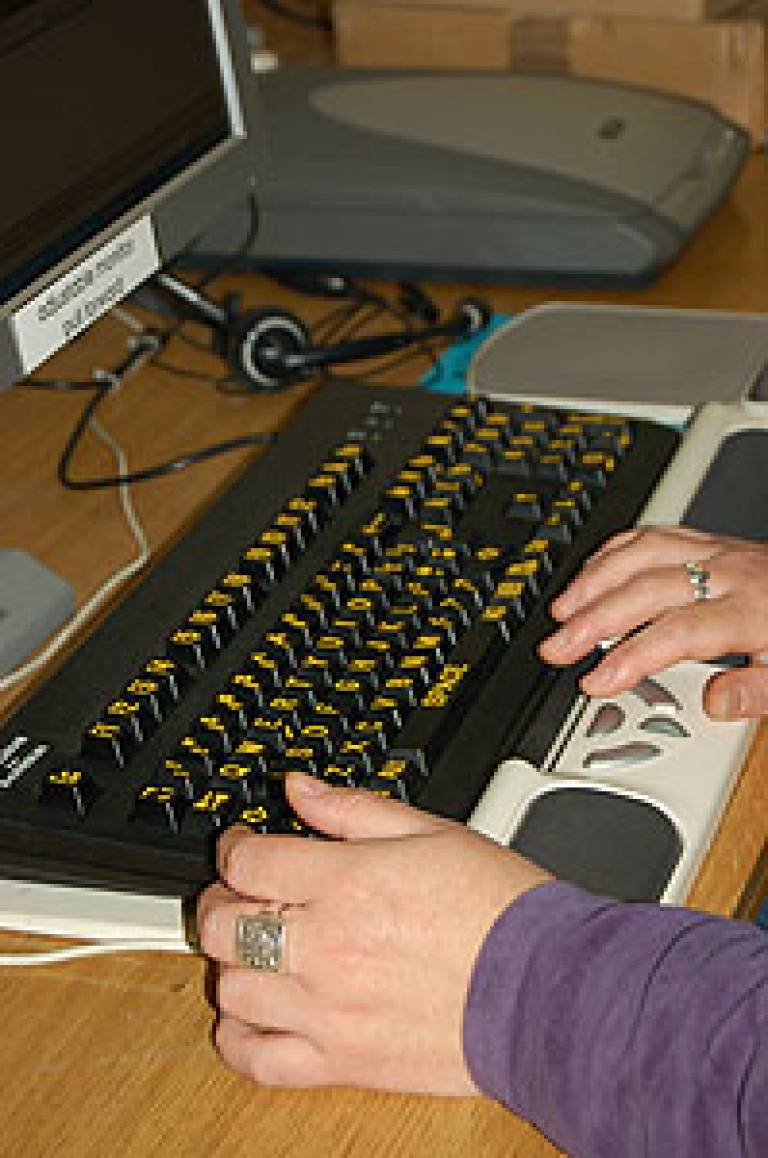Free Your Mind: Inclusive Technologies
17 November 2006
Put your mouse behind your monitor.
 Now, using only the keyboard, find out what public events are being held at UCL next month. Stumped? Most of us were in the accessibility workshop, held as part of Inclusive Technologies Day in November organised by the Learning Technologies Support Service and UCL Disability Services. (Hint: use [Tab] and [Alt]). The immediate feeling of helplessness provided a rapid but powerful insight into the obstacles faced by disabled students, and my ignorance about them.
Now, using only the keyboard, find out what public events are being held at UCL next month. Stumped? Most of us were in the accessibility workshop, held as part of Inclusive Technologies Day in November organised by the Learning Technologies Support Service and UCL Disability Services. (Hint: use [Tab] and [Alt]). The immediate feeling of helplessness provided a rapid but powerful insight into the obstacles faced by disabled students, and my ignorance about them.
"It's hard to put a number on how many disabled students there are at UCL," says Marion Hingston Lamb of the UCL Disability Centre. "Many applicants don't state that they are disabled on their application form, and a number make themselves known to Disability Services during the course of the academic year. We do know that last year, there were at least 810 disabled students at the university, and the proportion is growing each year." According to UCL Registry figures, disabled students represent around three per cent of the entire student community.
Working with all kinds of disabilities
For many people, the term 'disabled' still conjures up an image of a wheelchair, but there are many less visible conditions, from dyslexia to repetitive strain injury, which can place constraints on a student's learning experience. To devise ways around limitations, every student who discloses a disability is contacted by the university before they arrive. This gives them time before term starts to apply for the various allowances and grants available to cover the costs of communication support workers, such as sign language interpreters and note-takers, and specialist equipment. It also gives them a chance to meet tutors and discuss issues that may arise.
It's not just good practice for academics to cater for the needs of disabled students - it's a legal requirement. Since September 2002, all educational institutions have been required by the Special Education Needs Disability Act "to make reasonable adjustments to ensure that a disabled student is not placed at a substantial disadvantage". This means that individual academics must take matters into their own hands to check that their teaching methods and materials will not exclude anyone with any form of disability.
Making materials accessible
This may sound daunting for someone who has never taught a blind or deaf person, or indeed a student with Asperger syndrome or epilepsy. However, a lot of the work involved in making materials accessible is facilitated by the array of software and equipment tucked away in the Student Enabling Information Technology (SEnIT) suite in South Junction. Here students can type using their voice, organise essay plans visually, translate and print Word documents in Braille, and listen to internet pages read aloud. Ergonomic keyboards, adaptive mice, scanners and digital magnifiers also help students to knuckle down at the suite, which is open every day, even outside term time.
However, many of these technologies rely on material, especially web pages, being organised in a coherent way. Neil Martin of UCL Web Services explained that screenreaders (software that reads an internet page aloud) rely on headers to navigate around a page, and only see menus as lists if tags are used. If content editors don't provide a caption for an image or sound file using an Alt Tag, a blind user will be read a meaningless combination of letters and numbers. A font re-sizer button is easy to add but valuable to many.
The content management system that his team are building into websites across the university uses stylesheets that allow users to modify how they view websites, and to save these settings. For example, dyslexic people often find white backgrounds distracting, so they can opt for a different combination of colours. Donna Haugh, Faculty Information Support Officer, enlightened us to the plethora of services available that help web editors avoid pitfalls by simulating how disabled people experience them. Penny Everett, Learning Technologies Support Officer, demonstrated that taking a little time to use stylesheets in Word documents and bookmarks in pdfs can save disabled students hours in pinpointing parts of a text they need.
Everyone's a winner
Penny also observed that making the effort to include disabled students in all parts of the learning experience usually improves the experience of the whole class. Nowhere was this more obvious than in the role-play, in which Athina Chatzigavriil of the Information Services Academic and Applications Support Group deliberately gave a 'worst practice' lecture. Using crammed slides in garish colours, and gabbling through her lecture with her back to the room or staring down at her notes not only made it difficult for colour blind people, sign language interpreters and lipreaders, but also made it an extremely irritating experience for everyone. It was particularly embarrassing to witness the fuss she made of the deaf student, and the way she proceeded to address only the student's interpreter.
Tellingly, the workshop delegates only noticed a fraction of these errors, even though we were concentrating on observing them. However, we were encouraged when Penny assured us that, through necessity, most disabled people have a wry sense of humour about the obstacles that they face, and that the vast majority of these can be surmounted through a little preparation and consideration.
Image: Modified keyboards allow access to computers without relying on a mouse
 Close
Close

